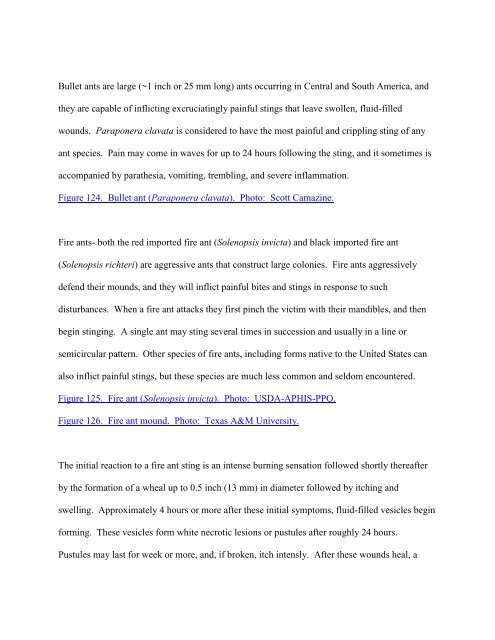Field Guide to Venomous and Medically Important Invertebrates ...
Field Guide to Venomous and Medically Important Invertebrates ...
Field Guide to Venomous and Medically Important Invertebrates ...
You also want an ePaper? Increase the reach of your titles
YUMPU automatically turns print PDFs into web optimized ePapers that Google loves.
Bullet ants are large (~1 inch or 25 mm long) ants occurring in Central <strong>and</strong> South America, <strong>and</strong><br />
they are capable of inflicting excruciatingly painful stings that leave swollen, fluid-filled<br />
wounds. Paraponera clavata is considered <strong>to</strong> have the most painful <strong>and</strong> crippling sting of any<br />
ant species. Pain may come in waves for up <strong>to</strong> 24 hours following the sting, <strong>and</strong> it sometimes is<br />
accompanied by parathesia, vomiting, trembling, <strong>and</strong> severe inflammation.<br />
Figure 124. Bullet ant (Paraponera clavata). Pho<strong>to</strong>: Scott Camazine.<br />
Fire ants- both the red imported fire ant (Solenopsis invicta) <strong>and</strong> black imported fire ant<br />
(Solenopsis richteri) are aggressive ants that construct large colonies. Fire ants aggressively<br />
defend their mounds, <strong>and</strong> they will inflict painful bites <strong>and</strong> stings in response <strong>to</strong> such<br />
disturbances. When a fire ant attacks they first pinch the victim with their m<strong>and</strong>ibles, <strong>and</strong> then<br />
begin stinging. A single ant may sting several times in succession <strong>and</strong> usually in a line or<br />
semicircular pattern. Other species of fire ants, including forms native <strong>to</strong> the United States can<br />
also inflict painful stings, but these species are much less common <strong>and</strong> seldom encountered.<br />
Figure 125. Fire ant (Solenopsis invicta). Pho<strong>to</strong>: USDA-APHIS-PPQ.<br />
Figure 126. Fire ant mound. Pho<strong>to</strong>: Texas A&M University.<br />
The initial reaction <strong>to</strong> a fire ant sting is an intense burning sensation followed shortly thereafter<br />
by the formation of a wheal up <strong>to</strong> 0.5 inch (13 mm) in diameter followed by itching <strong>and</strong><br />
swelling. Approximately 4 hours or more after these initial symp<strong>to</strong>ms, fluid-filled vesicles begin<br />
forming. These vesicles form white necrotic lesions or pustules after roughly 24 hours.<br />
Pustules may last for week or more, <strong>and</strong>, if broken, itch intensly. After these wounds heal, a

















